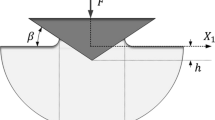Abstract
During indentation, it is often important to determine the relationship between the average pressure and the yield strength. This work uses slip-line theory to determine this relationship for the case of a rigid sphere indenting a frictionless perfectly plastic half-space (i.e., no hardening). The results show that the ratio between the average contact pressure and the yield strength decreases as the depth of indentation is increased. Note that the slip-line analysis does not include the effects of pileup or sink-in deformations. However, the slip-line theory has also been compared to data generated using the finite element method (FEM). The theory and the FEM results appear to agree well.





Similar content being viewed by others
References
Jackson, R.L., Kogut, L.: A comparison of flattening and indentation approaches for contact mechanics modeling of single asperity contacts. ASME J. Tribol. 128(1), 209–212 (2006)
Ishlinskii, A.J.: The problem of plasticity with axial symmetry and Brinell’s Test [An English Translation has been published by Ministry of Supply, A.R.D. (1947)]. J. Appl. Math. Mech. (U.S.S.R) 8, 233 (1944)
Jackson, R.L., Green, I.: A finite element study of elasto-plastic hemispherical contact against a rigid flat. ASME J. Tribol. 127(2), 343–354 (2005)
Tabor, D.: The hardness of materials. Clarendon Press, Oxford (1951)
Wadwalkar, S.S., Jackson, R.L., Kogut, L.: A study of the elastic-plastic deformation of heavily deformed spherical contacts. IMechE Part J: J. Eng. Tribol. 224(10), 1091–1102 (2010)
Jackson, R., Green, I., Marghitu, D.: Predicting the coefficient of restitution of impacting elastic-perfectly plastic spheres. Nonlinear Dyn. 60(3), 217–229 (2010)
Mesarovic, S.D., Fleck, N.A.: Spherical indentation of elastic–plastic solids. Proc. R. Soc. Lond. A: Math. Phys. Eng. Sci. 455(1987), 2707–2728 (1999). doi:10.1098/rspa.1999.0423
Kogut, L., Komvopoulos, K.: Analysis of spherical indentation cycle of elastic-perfectly plastic solids. J. Mater. Res. 19, 3641–3653 (2004)
Ye, N., Komvopoulos, K.: Indentation analysis of elastic-plastic homogeneous and layered media: criteria for determining the real material hardness. J. Tribol. Trans. ASME 125(4), 685 (2003)
Alcalá, J., Esqué-de los Ojos, D.: Reassessing spherical indentation: contact regimes and mechanical property extractions. Int. J. Solids Struct. 47(20), 2714–2732 (2010). doi:10.1016/j.ijsolstr.2010.05.025
Yu, W.P., Blanchard, J.P.: An elastic-plastic indentation model and its solutions. J. Mater. Res. 11(9), 2358–2367 (1996). doi:10.1557/Jmr.1996.0299
Chang, W.R., Etsion, I., Bogy, D.B.: An elastic-plastic model for the contact of rough surfaces. ASME J. Tribol. 109(2), 257–263 (1987)
Zhao, Y., Maletta, D.M., Chang, L.: An asperity microcontact model incorporating the transition from elastic deformation to fully plastic flow. ASME J. Tribol. 122(1), 86–93 (2000)
Kogut, L., Etsion, I.: Elastic-plastic contact analysis of a sphere and a rigid flat. ASME J. Appl. Mech. 69(5), 657–662 (2002)
Field, J.S., Swain, M.V.: A simple predictive model for spherical indentation. J. Mater. Res. 8(02), 297–306 (1993). doi:10.1557/JMR.1993.0297
Follansbee, P.S., Sinclair, G.B.: Quasi-static normal indentation of an elasto-plastic half-space by a rigid sphere—I: analysis. Int. J. Solids Struct. 20(1), 81–91 (1984). doi:10.1016/0020-7683(84)90078-7
Biwa, S., Storåkers, B.: An analysis of fully plastic Brinell indentation. J. Mech. Phys. Solids 43(8), 1303–1333 (1995). doi:10.1016/0022-5096(95)00031-D
Richmond, O., Morrison, H.L., Devenpeck, M.L.: Sphere indentation with application to the Brinell hardness test. Int. J. Mech. Sci. 16(1), 75–82 (1974). doi:10.1016/0020-7403(74)90034-4
Taljat, B., Pharr, G.M.: Development of pile-up during spherical indentation of elastic–plastic solids. Int. J. Solids Struct. 41(14), 3891–3904 (2004). doi:10.1016/j.ijsolstr.2004.02.033
Johnson, K.L.: Contact Mechanics. Cambridge University Press, Cambridge (1985)
Jackson, R.L., Green, I.: A statistical model of elasto-plastic asperity contact between rough surfaces. Trib. Int. 39(9), 906–914 (2006)
Kogut, L., Jackson, R.L.: A comparison of contact modeling utilizing statistical and fractal approaches. ASME J. Tribol. 128(1), 213–217 (2005)
Kogut, L., Etsion, I.: A finite element based elastic-plastic model for the contact of rough surfaces. Tribol. Trans. 46(3), 383–390 (2003)
Ciavarella, M., Delfine, G., Demelio, G.: A ‘re-vitalized’ Greenwood and Williamson model of elastic contact between fractal surfaces. J. Mech. Phys. Solids 54(12), 2569–2591 (2006)
Sepehri, A., Farhang, K.: Closed-form equations for three dimensional elastic-plastic contact of nominally flat rough surfaces. J. Tribol. Trans Asme 131(4) (2009). doi:10.1115/1.3204775
Beheshti, A., Khonsari, M.M.: Asperity micro-contact models as applied to the deformation of rough line contact. Tribol. Int. 52, 61–74 (2012). doi:10.1016/j.triboint.2012.02.026
Lee, C.-H., Eriten, M., Polycarpou, A.A.: Application of elastic-plastic static friction models to rough surfaces with asymmetric asperity distribution. ASME J. Tribol. 132(3), 031602-031601-031611 (2010)
Li, L., Etsion, I., Talke, F.E.: Contact area and static friction of rough surfaces with high plasticity index. ASME J. Tribol. 132(3), 031401-031401-031410 (2010)
Gao, Y.F., Bower, A.F.: Elastic-plastic contact of a rough surface with Weierstrass profile. Proc. R. Soc. A 462, 319–348 (2006)
Jackson, R.L., Streator, J.L.: A multiscale model for contact between rough surfaces. Wear 261(11–12), 1337–1347 (2006)
Goedecke, A., Jackson, R., Mock, R.: A fractal expansion of a three dimensional elastic–plastic multi-scale rough surface contact model. Tribol. Int. 59, 230–239 (2013)
Author information
Authors and Affiliations
Corresponding author
Rights and permissions
About this article
Cite this article
Jackson, R.L., Ghaednia, H. & Pope, S. A Solution of Rigid–Perfectly Plastic Deep Spherical Indentation Based on Slip-Line Theory. Tribol Lett 58, 47 (2015). https://doi.org/10.1007/s11249-015-0524-3
Received:
Accepted:
Published:
DOI: https://doi.org/10.1007/s11249-015-0524-3




